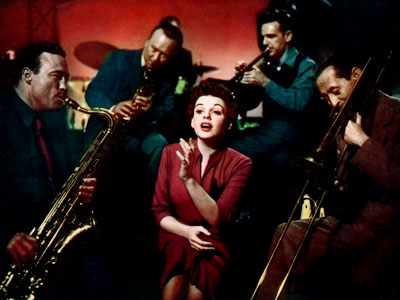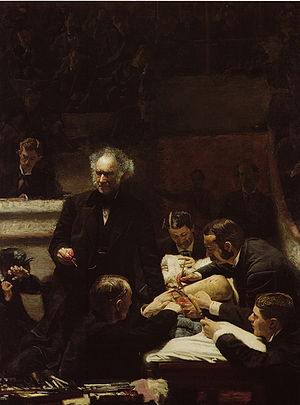“Money costs too much.”
Ross Macdonald, The Goodbye Look
Archives for July 2010
EXHIBITION
Charles Burchfield: Fifty Years as a Painter (DC Moore Gallery, 724 Fifth Ave., up through Sept. 25). If you’ve already paid a visit to the Whitney’s idiosyncratic large-scale retrospective of the work of the visionary modern American watercolorist whose studies of small-town life have won the admiration of everyone from Edward Hopper to Jerry Saltz, then check out this small, tightly focused museum-quality show. It’s more than a mere pendant (TT).
TT: O.K. for sound
Today’s episode of Fresh Air is all about the history of songs in Hollywood, and the producers invited those who follow the series on Twitter to vote for their favorite movie song. My snap response was to nominate “The Shadow of Your Smile,” but the more I thought about it, the less sure I was that I could pick a single song, or even five, to represent the richness of the field. So I thought a little bit more, and came up with this list of my fifteen favorite songs that were written for use in Hollywood films:
• “Have Yourself a Merry Little Christmas” (Blane-Martin, from Meet Me in St. Louis)
• “How About You?” (Lane-Freed, from Babes on Broadway)
• “I’m Old Fashioned” (Kern-Mercer, from You Were Never Lovelier)
• “Let’s Face the Music and Dance” (Berlin, from Follow the Fleet)
 • “The Man That Got Away” (Arlen-Gershwin, from A Star Is Born)
• “The Man That Got Away” (Arlen-Gershwin, from A Star Is Born)
• “Moon River” (Mancini-Mercer, from Breakfast at Tiffany’s)
• “One for My Baby” (Arlen-Mercer, from The Sky’s the Limit)
• “The Shadow of Your Smile” (Mandel-Webster, from The Sandpiper)
• “Something’s Gotta Give” (Mercer, from Daddy Long Legs)
• “Spring Will Be a Little Late This Year” (Loesser, from Christmas Holiday)
• “Swinging on a Star” (Van Heusen-Burke, from Going My Way)
• “That’s Entertainment” (Schwartz-Dietz, from The Band Wagon)
• “They Can’t Take That Away From Me” (Gershwin-Gershwin, from Shall We Dance)
• “The Way You Look Tonight” (Kern-Fields, from Swing Time)
• “You’d Be So Nice to Come Home To” (Porter, from Something to Shout About)
Two things struck me about this list. The first is that all of the songs on it are “classic” golden-age pop. I love rock, but the only post-classic song written specifically for a film that came to mind as a possible candidate was Aimee Mann’s “Save Me” (from Magnolia).
The second is that seven of these songs were written for Fred Astaire to sing on screen, a statistic that speaks for itself.
And which one is the best of the lot? If you tied me down and tickled me, I might say “Moon River” to get you to stop. But tickle me again tomorrow and you could get a different answer….
TT: Almanac
“Nothing wrong with Southern California that a rise in the ocean wouldn’t cure.”
Ross Macdonald, The Moving Target
TT: A masterpiece revisited
Thomas Eakins’ “The Gross Clinic,” his most famous painting, has just been restored by conservators at the Philadelphia Museum of Art, which became co-owner of the painting (together with the Pennsylvania Academy of the Fine Arts) two years ago. This news reminded me that I first saw “The Gross Clinic” in person when it was on display at the Met eight years ago, and that I wrote a piece about the experience for The Wall Street Journal. (It was the prototype for what later evolved into the Journal‘s “Masterpiece” column.)
To celebrate the restoration of “The Gross Clinic,” here is my piece, reprinted for the first time since it was originally published in 2002.
* * *
Neville Cardus, the English music critic, spent World War II in Australia. Most Aussies then were well behind the cultural curve, and Cardus learned to his dismay that the centerpiece of the first concert he was to review for the Sydney Morning Herald was Beethoven’s Fifth Symphony, the “Mona Lisa” of classical music. What could he possibly say about a warhorse he’d heard at least a hundred times?
That night, though, he glanced around the concert hall and realized that at least half ot the audience had never before heard a performance of Beethoven’s Fifth. “To those Australians, in the Sydney Town Hall, the Fifth Symphony was a revelation,” he later recalled. “I found this a tremendous inspiration….the concert was for me an illumination and living proof that there are no hackneyed masterpieces, only hackneyed critics.”
 I thought of Neville Cardus the other day when I went to an exhibition of the paintings of Thomas Eakins at New York City’s Metropolitan Museum of Art. The centerpiece is “The Gross Clinic,” Eakins’ 1875 portrayal of an osteomyelitis operation. It’s one of the best-known American paintings of the 19th century, so I wasn’t expecting to be startled by it. “The Gross Clinic” is so well known, in fact, that I forgot I’d never really seen it in person, since it normally hangs not in a museum but at the Jefferson Medical College in Philadelphia, a bit off the beaten path of most critics.
I thought of Neville Cardus the other day when I went to an exhibition of the paintings of Thomas Eakins at New York City’s Metropolitan Museum of Art. The centerpiece is “The Gross Clinic,” Eakins’ 1875 portrayal of an osteomyelitis operation. It’s one of the best-known American paintings of the 19th century, so I wasn’t expecting to be startled by it. “The Gross Clinic” is so well known, in fact, that I forgot I’d never really seen it in person, since it normally hangs not in a museum but at the Jefferson Medical College in Philadelphia, a bit off the beaten path of most critics.
The Met has hung “The Gross Clinic” by itself on a darkish-blue wall, and as you step through the entrance, everything else in the gallery disappears. All you see is a huge canvas, eight feet tall and six and a half feet wide, encased in a heavy gold frame. The sheer size of “The Gross Clinic” caught me off guard–in my mind, it was a medium-sized work suitable for display in the waiting rooms of the doctors’ offices where it is still so often found–and I needed a few seconds to catch my breath and let the half-remembered details snap back into focus.
“The Gross Clinic” is set in the amphitheater of Jefferson Medical College. Four earnest-looking doctors in ties and jackets are clustered around a patient, their hands covered with blood as they probe his helpless body. Off to the left, a horrified woman shields her eyes. (She is thought to be the patient’s mother.) Meanwhile, Dr. Samuel Gross, a tight-lipped, balding surgeon-teacher who towers over the operating table like a colossus, lectures to the students surrounding him in tiers of ascending seats, a scalpel clutched in his bloody right hand.
To run across “The Gross Clinic” in an art book is anything but startling–movies and TV long ago accustomed us to close-up carnage–but to see the real thing up close is to feel as though you’ve been slapped in the face. Just for a moment, you can understand why the critics of 1875 were so horrified by so unsparingly candid a portrayal of the surgeon’s life. One squeamish critic called it “revolting to the last degree.”
First the shock, then the beauty: Eakins has turned this violent vignette into a complex yet perfectly balanced composition, guiding you from point to point with supreme finesse. Your eye is drawn irresistibly to the garish red blood on the hands of the surgeons–and to the spotlit forehead of Dr. Gross, leaping forward out of a somber sea of brown and black. Then you see the heads of the four doctors, arranged in a tight semi-circle. Then the frightened woman and, right behind her, a mustached clerk, taking down Dr. Gross’ words for posterity. Then the shadowy onlookers, among them Eakins himself, sketching the proceedings on a pad. (This Hitchcock-like cameo is hard to make out in many reproductions, but it’s as plain as day when you’re standing in front of the painting.)
As I gazed intently at “The Gross Clinic,” I suddenly became aware of two elderly ladies standing next to me. “Boy, they’ve come a long way in medicine!” one said. I smiled, but I knew she had a point. “The Gross Clinic” is more than just a work of art–it’s also a piece of social history. The radiant forehead of Dr. Gross is a potent symbol of the Victorian faith in the redemptive power of science, in which most 19th-century Americans were the truest of believers. Few of us have that kind of faith today: The horrors of the 20th century knocked it out of us. But Thomas Eakins had it, and he makes you feel it, too. That is part of the overwhelming effect of “The Gross Clinic,” as much as its dramatic composition or Rembrandt-like palette.
I walked down the steps of the Met, a little dazed by my encounter with a painting whose greatness had been dulled by familiarity, and asked myself, “How on earth could I possibly have thought I ‘knew’ ‘The Gross Clinic’? I didn’t know it at all!” That’s the way every critic should feel whenever he comes into the presence of an over-familiar masterpiece, be it Beethoven’s Fifth or “Romeo and Juliet.” For we can never fully “know” a great work of art. It is bigger than we are, bigger than life, which is why it offers the possibility of permanent renewal and refreshment. All we have to do is see it for the first time–every time.
TT: Almanac
“I live in a house that was quite modern for its time, in a neighborhood that broke with the grid and tried to bring new ideas to the standard city model. I love most architecture that tried to do something different, right up until the point where the expression of one individual became the only thing that mattered. Architecture has always been a collaboration–even if there’s one Genius designing the building, he or she collaborates with the developers, the occupants, and the street where the building exists. Now we have enormous mounds of narcissistic concrete and metal, housing the yawps and shouts of artists who cannot put the past into the shredder fast enough.
“I hate feeling this way.”
James Lileks, The Bleat, July 7, 2010
DANCE
Pilobolus Dance Theatre (Joyce Theater, 175 Eighth Ave., closes Aug. 7). These are hard times for the much-loved modern dance troupe, which is coming to grips with the recent death of Jonathan Wolken, one of its founding members. Yet there can be no better way to celebrate Wolken’s life than to pay a visit to Pilobolus’ annual summer season at the Joyce Theater. The company is performing three mixed bills, the first of which features the New York premiere of Hapless Hooligan in “Still Moving,” a collaboration with Art Spiegelman. No matter which one you see, you’ll be entranced (TT).
BOOK
Brooke Berman, No Place Like Home: A Memoir in 39 Apartments (Harmony, $23). The author of Hunting and Gathering came to Manhattan at the age of eighteen in the hopes of someday becoming a full-time professional playwright. Talented, inexperienced, naïve, and broke, she spent the next twenty years sharing microscopically small apartments, sleeping on futons, bouncing from roommate to roommate and gradually finding herself along the way. Now she’s written a memoir of her formative years, and it’s a lovely piece of work, at once charming and deeply felt. No Place Like Home is one of the best books I’ve read about how young artists make their way–or not–in an unforgiving world (TT).
